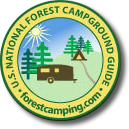Cooking with the correct temperature
Achieving the correct temperature when cooking is a challenge for any camp cook. News flash! Campfires don’t have a gauge. Whether it’s the interior temperature of a chunk of meat or the temperature need to actually cook that chunk of meat, practice makes perfect.
How to know you’ve got the heat right
Here’s an aid to getting the correct temperature when cooking in a Dutch Oven (also works for cast iron skillets and heavy pots). I recommend printing the table so you can take it with you.

Once you’ve got the camp fire going and can see the glow from a pile of ashy coals glowing you might be wondering how to determine you’ve got the correct temperature to cook whatever you have planned. Using either an open campfire or kettle-style bar-b-que way to cook, there are two ways to approximate the temperature. Both need some practice to get good but both are fairly reliable. Since I am basically lazy and unless I need a skillet for cooking dinner, I tend to use the first method more often.
The first is to hold your hand or the inside of your wrist close to the cooking surface and counting one-thousand-one, two-thousand-two, and on, until the heat becomes unbearable.
6 to 8 = 250 to 300 degrees F
4 to 5 = 350 to 400 degrees F
2 to 3 = 450 degrees F
The second way is to sprinkle a little all-purpose flour in a cold skillet and then put it on the heat. Let it sit for five minutes before removing it from your fire. If there has been no change in color, the cooking temperature is less than 250 degrees. Pale tan indicates 300 degrees, a golden brown about 350 degrees, and dark brown about 400 degrees.
Once you have achieved the temperature you need to cook your meal, don’t forget to be careful when handling any hot pot or skillet.


